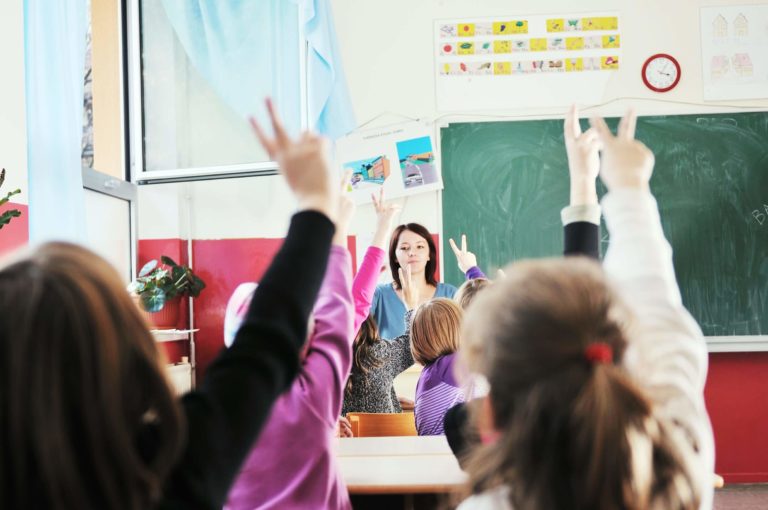Walking down the hallways of my school, a smile breaks across my face as I hear “Oh Class, Oh Class” and a choral response of “Oh Yes, Oh Yes!” Students are engaged and they are ready to learn; the excitement is in their voices. To what do we contribute this level of participation? Whole brain teaching, of course!
What is Whole Brain Teaching?
Whole brain teaching is an instructional approach that is gaining momentum through the integration of social-emotional learning into a highly energetic, authentically engaged learning process. There is a basic lesson structure that each learning moment follows, giving students ownership of their learning through mimicry.
The whole brain teaching learning circle focuses on four main areas:
- Attention-Getter
- Brain Engager
- Direct Instruction
- Collaborative Learning
Attention-Getter
A teacher cannot teach if a student is not paying attention. In order to gain students’ attention, the teacher begins with “Class-Yes”. The teacher says, “Class” and the students are taught to respond with “Yes”. Yes is more than a word that is spoken, though. The teacher explicitly teaches the expectations that come with a “Yes” response. They freeze what they are doing, turn and track the teacher, and fold their hands in front of them. If a student does not complete all three components, the teacher reviews and allows students to practice what should happen during the attention getter. Now that you have everyone’s attention, it is time to engage students in the learning.
Brain Engager
“Mirror Words,” shouts the teacher, reminding me of Mary Katherine Gallagher doing the “Superstar” skit on Saturday Night Live. Her hands fly up looking like rearview mirrors and the students do the same. Everyone participates because she has already gained their attention. She is having fun teaching and the students are sponges, excited and ready to engage in what the teacher has planned for them today.
Direct Instruction
One-minute lessons are facilitated for direct instruction. Planning for instruction includes gestures that go with each major concept and that word/concept keeps the same gesture throughout the entire lesson. Students then have an association of a word to a gesture and the information that is related to both. For example, when a teacher is teaching a noun, she puts her hands together in front of her indicating it is an object. Every time she says the word “noun”, she makes the same motion with her hands.
In whole brain teaching, the teacher breaks up information into short chunks, using large hand gestures, varying the intonation of her voice by speaking loudly and then softly, quickly then slowly. The greater the variance, the more likely students are to recall and use the information. The teacher leads the students through one chunk and they repeat, doing the same motions and saying the same words. This mimicry allows for students to engage with the information kinesthetically, visually, and auditorily.
At the end of the minute, the teacher states to the class,” Mirrors off!” and the students repeat.
Collaborative Learning
For this segment of the lesson, the teacher proclaims “Teach!” and the students respond with “Okay!” The students then face a partner and paraphrase the learning, which is a skill within its own right. Formative assessment is happening every minute as the teacher combs the room, listening for the paraphrase. When a student is not participating, the teacher whispers, “Bigger gestures, please.”
Increasing rigor and complex thinking can happen in this phase of the learning. Students can collaborate to complete higher-order thinking tasks including comparing, contrasting, synthesizing, analyzing, and evaluating.
Once the cycle is complete, the teacher starts again by getting the students’ attention and providing the next minute of instruction.
What are the Benefits of Whole Brain Teaching?
Neuroscience research shows that learning is not a one-dimensional process. Providing learning experiences that engage multiple areas of the brain allow students to engage in authentic learning where previous knowledge is activated and new information is integrated. Being intentional in the design of the instruction by incorporating the whole brain through hearing, seeing, speaking, moving, and reasoning allows students to create memories that are stored throughout the brain instead of in a single area.
Trauma and negativity affect the brain chemistry and, oftentimes, will block sensory pathways. We know our students do not always come from homes that are meeting all of their basic needs. If a child has experienced trauma before coming to school, engagement can be quite difficult, and nearly impossible, if the teacher does not do something to stimulate positive emotion in the student so learning can occur.
Whole brain teaching starts with positivity, and when students are not engaged, the teacher assumes the responsibility of providing more time to practice rather than scolding. When students are having fun in their learning, their brain can receive, process, and retain information, serving as a catalyst for learning; a benefit of whole brain teaching.
When and for Which Students is Whole Brain Teaching Most Appropriate?
Whole brain teaching is not a typical classroom. This approach is loud and animated. The teacher is an interactive facilitator of learning who has intricately prepared to provide words and gestures that will solidify content for students through foundational learning.
While this approach is awesome for students who have traumatic backgrounds, there are groups of students that would find this learning approach overwhelming. If you have a student that is shy, quiet, or has sensory processing issues, this may not be the strategy for them. However, research has shown that there are high rates of learning in African-American males and students with ADHD due to the multi-sensory approach, high energy, high engagement strategies that are used. Knowing your students can help determine if whole brain teaching is a valid method of instruction for your students.




